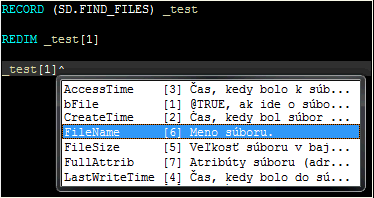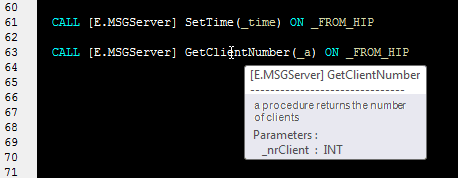...
- Tabs on the top - if the option is checked, the tabs occur at the top, otherwise the tabs are at the bottom.
- Move right - moves the tab one position to the right.
- Move left - moves the tab one position to the left.
- New window - opens the tab in a separate window.
- Close tab - closes the tab over which the popup menu was displayed (Ctrl+W closes the current tab).
- Show picture - opens the edited picture and minimizes the ESL script. The option is available only for the script of active picture, for the script of event is unavailable.
Notes:
A title bar of tab window and CNF (if the window is maximized) contain the name of active tab. If the tab window is minimized or hidden and the new script is opened the tab window will be displayed again. The insertion point is on the area for editing of the current tab.
...
| Shortcut | Action |
|---|---|
| CTRL+N | Opens the tab in a separate window. |
| CTRL+O | Moves the tab one position to the left. |
| CTRL+P | Moves the tab one position to the right. |
| CTRL+W | Closes the actual tab. |
| F12 | Opens the edited picture and minimizes the ESL script. |
ESL editor features:
...
- Automatic color differentiation of key words: .
- Automatic color differentiation of texts: correctly written: , incorrectly written: .
- After a successful Syntax check:
- Typing the symbol '^' after the name of an object of Structured variable type or after the name of a local variable of RECORD type shows the list of all structure columns with the column number and description. The columns are listed in alphabetical order.
- Pointing the mouse cursor to a local variable, or a structured variable item displays information about its type and the place where it is declared (in the debugging mode, the value of the variable is shown).
- Right-mouse click above identifier (local variable, procedure name) opens the local popup menu containing the only item - Go to definition - after clicking the item the cursor is automatically moved to the declaration of the identifier.
- Typing the symbol '^' after the name of an object of Structured variable type or after the name of a local variable of RECORD type shows the list of all structure columns with the column number and description. The columns are listed in alphabetical order.
- After an unsuccessful Syntax check or Compilation, double-clicking an error from the lists of errors (5) moves the mouse cursor to where the error occurred.
- Pressing F1 (help) when the cursor is pointed to the name of a function / action opens the help document for the given function/action/picture event.
- Automatic display of function description and types of parameters. If user enters the function name and the first bracket in script editor the window will appear where the function and its parameters are described. Parameter is highlighted in dark blue color when you proceed to the new parameter.
Example:
- Automatic display of action and its parameters. If user enters the action name and presses the button SPACE the window with action's declarations will be shown in editor.
Examples:
- When you write an object identifier (picture object identifier or system server event identifier) and the symbol "]" after it the list of RPC procedures and interface, defined for this object, will display. The selected definition of procedure or interface will be added to script editor.
Example:
- When entering the symbol "^" after the interface name, the list of procedures, defined for this interface, displays. The selected definition of procedure will be added to script editor.
Example:
- View of RPC procedure description called in ESL script. This property allows to write the description of RPC procedures which is visible in a different script. The comments and parameters of RPC procedure are shown in ESL script. The description can consist of one or more rows, the empty row is not allowed. The declaration of procedure have to follow the description (without the empty rows). The description starts with a character ";", like the comments.
Example of description:
Example of display:
Automatic indentationKotva odsadenie odsadenie
When writing the ESL script and moving on the new line, ESL editor automatically indents the current line (according to the first non-zero line) and move the cursor on the given position.
Features of automatic indentation:- When moving on the new line after the action (e.g. RPC, PROCEDURE, PUBLIC, FOR, DO_LOOP, IF... ) in ESL editor, the text is automatically indented by 2 characters to the right from the previous line.
- When moving on the new line after the action (e.g. END_LOOP, ENDIF... ) in ESL editor, the text is automatically indented by 2 characters to the left from the previous line.
- When pressing Ctrl+i, the selected text is formatted according to the previous settings. For this action is important the indentation of the first line within the selected lines.
The automatic indentation may be enabled / disabled in the dialog box Settings under the menu System.Keyboard shortcuts:
Shortcut Action CTRL+K Causes the current line, or current selection of lines to be commented. CTRL+SHIFT+K Removes the comment of current line, or current selection of lines. CTRL+F Displays the dialog box to search or to replace a text in the script. CTRL+G Goes to given line in the text. CTRL+i Indents the selected rows in the script. The indentation of the first row of the selected part of script is the decisive. CTRL+S For active picture script - saving the picture.
For script of an object of Event type - saving.CTRL+1 Opens a list of D2000 system objects. CTRL+2 Opens a list of predefined constants. CTRL+3 Opens a list of functions. CTRL+4 Opens a list of actions. CTRL+5 Opens a list of local variables. CTRL+6 Opens a list of value attributes of object or local variable. CTRL+~ ESL script editor will complete automatically a written word according to next suitable one (from cursor position) and later according to its type (function, constant, action, ...). To add other adequate words press the button repeatedly. CTRL+> Shows tool tip in ESL script editor even if the automatic tool tip is switch off.
...
ESL Editor within String detects the references to dictionary. If some reference to a dictionary (key), which has not defined yet, is identified, it will be colored as Error (see the dialog above).
Example:
The key D2_ActAlarm exists in the dictionary, but D2_ActAlarmAAAAA does not exist.
...










